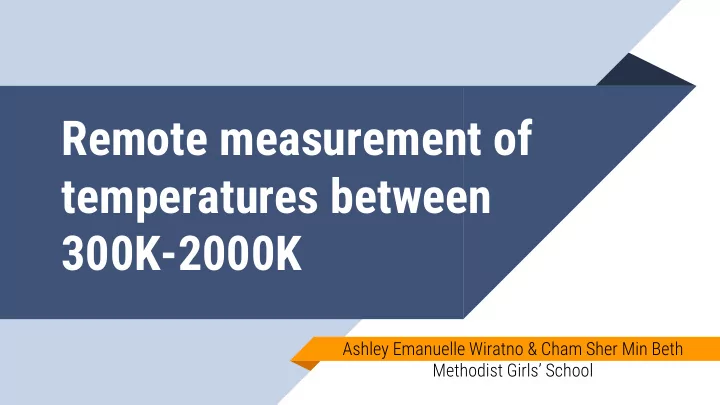

Remote measurement of temperatures between 300K-2000K Ashley Emanuelle Wiratno & Cham Sher Min Beth Methodist Girls’ School
1 Introduction 2
Objectives ● Improving the accuracy of contactless infrared temperature sensors ● Increase the effectiveness and usefulness of contactless temperature sensors. ● Calibration of sensors ○ to display the information on a separate webpage wirelessly 3
Background Information ● Black bodies are theoretically perfect emitters and absorbers of radiation ● Stefan- Boltzmann Law formula, P = єσAT 4 ○ Radiation is proportional to 4th power of temperature ● Planck's law 4
Graph of radiation against wavelength according to Planck’s Law 5
Background information Common errors in infrared temperature sensors include: ● Not measuring absolute temperature ○ an increase in ambient temperature may cause errors ● Taking the average temperature of too large an area 6
2 Experimental Process 7
MLX90621 8
MLX90621 ● The two MLX90621 thermopile arrays successfully measured the temperature and uploaded a table 9
ZTP-135SR 10
Calibration Graph of the log10 of thermistor resistance ( kΩ ) against ambient temperature (k) 11
Calibration Voltage from multimeter/V 12 Reading on program
Calibration Voltage /V 13 Temperature of heat source/k
Control variables Control variables Amount Surface area 100 cm 2 Distance from heat 11 cm source 14
Calibration 11 cm 15
Calibration Ratio Ratio Temperature of heat source/k Temperature of heat source/k 16
3 Limitations 17
Limitations and Further Research ● Our current sensor is only calibrated for a specific distance and surface area away from the object ● Further research could include the distance and surface area as variables through the use of the Stefan-Boltzmann Law ● The relationship between distance and surface area 18
Acknowledgements We would like to show our gratitude to Professor Lee Choon Keat Paul for his guidance on this project. We would like to thank Mr Lim Lee for his support. We would also like to acknowledge Nanyang Technological University and the National Institute of Education for for organising the Nanyang Research Programme Junior. 19
Thank you! 20
Recommend
More recommend